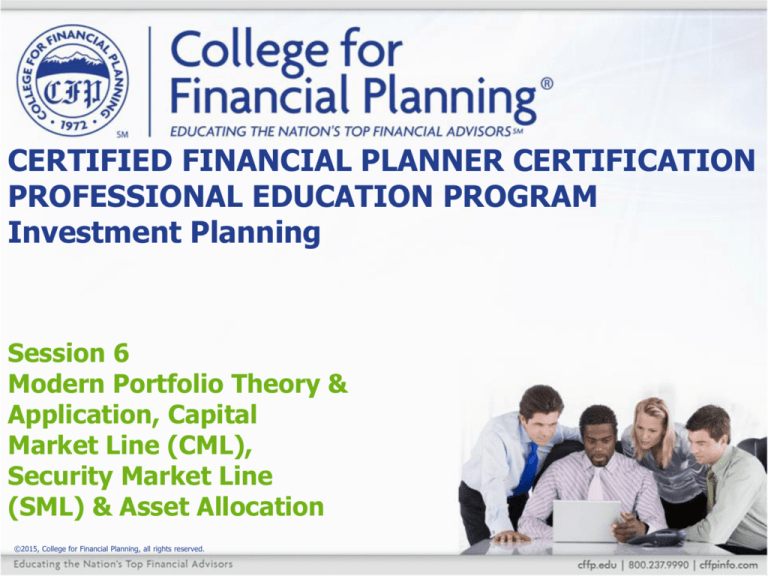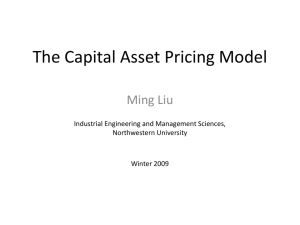
CERTIFIED FINANCIAL PLANNER CERTIFICATION
PROFESSIONAL EDUCATION PROGRAM
Investment Planning
Session 6
Modern Portfolio Theory &
Application, Capital
Market Line (CML),
Security Market Line
(SML) & Asset Allocation
©2015, College for Financial Planning, all rights reserved.
Session Details
Module
3
Chapter(s) 1, 2
LOs
3-1
Explain terminology related to modern
portfolio theory (MPT) and the Markowitz
efficient frontier model, and relate the
concepts of risk and return to modern
portfolio theory.
3-2
Evaluate the capital asset pricing model
(CAPM) as it relates to the efficient frontier,
and the creation of the security market line
(SML).
3-3
Explain the multi-factor components of the
arbitrage pricing theory.
6-2
Markowitz Portfolio Theory
Assumptions made:
• Investors are risk-averse.
• Decisions are made based on
•
•
•
•
•
expected risk and return only.
Investors have homogeneous
expectations regarding return
and risk for opportunities in the
market.
Investors have a common
one-period time horizon.
Investors have free access
to all information.
There are no transaction costs.
The capital market is perfectly
competitive.
6-3
Efficient Frontier
E(Ri)
C
D
B
A
Si
6-4
Optimal Portfolio
U4 U3 U2 U1
E(Ri)
X
Si
6-5
Capital Asset Pricing Model (CAPM)
The CAPM has:
• MACRO component explains risk and return in a
portfolio context (uses standard deviation)
• MICRO component explains individual stock
returns (uses beta)
• The micro component is the one used to value
stocks:
r rf (rm rf )β
6-6
Capital Asset Pricing Model (CAPM)
• The CAPM determines the total return required
for the amount of risk being taken (as
measured by beta).
r rf (rm rf )β
• The difference between the return of the
market and risk-free rate is the “market risk
premium” (Rm – Rf).
6-7
The Capital Market Line (uses SD)
Return
%
B
Z
Y
A
rf
X
Risk: Portfolio
Standard Deviation ( p )
6-8
Security Market Line (uses beta)
SML
E(Ri)
M
RF
0
1.0
bi
6-9
CAPM Example
Assume the risk-free rate is 5%, and the
expected return is 13%.
Asset
R
Beta
(required return)
W
0.8
11.4%
X
Y
Z
1.5
1.0
-0.5
17%
13%
1%
6-10
SML & Equilibrium
Expected Return
20
15
W Y
X
10
Z
5
-1
-0.5
0
0.5
1
1.5
2
Beta
6-11
SML & Inflation
E(Ri)
RFR*
RFR
New
SML
Original
SML
Beta
6-12
SML & Risk Aversion
E(Ri)
RFR
New
SML
Original
SML
6-13
Arbitrage Pricing Theory (APT)
Multi-Factor Model
Four factors used are
unexpected changes in:
• Inflation
• GDP changes
• Risk premiums
• Interest rates
(yield curves)
6-14
Risk Tolerance Measurement
•
•
•
•
•
Loss aversion
Risk aversion
Liquidity available
Life cycle phase
Value at risk –
Monte Carlo
simulation
6-15
Asset Allocation Strategies
•
•
•
•
•
Strategic allocation
Tactical allocation
Dynamic allocation
Core/Satellite allocation
Public allocation
recommendations
by investment
firms
Fund 1
Fund 2
Fund 3
Fund 4
6-16
Question 1
Which of the following illustrate the important
factors in the construction of a portfolio under
the principles of modern portfolio theory?
I. investors want to maximize utility
II. correlation between pairs of securities
III.beta as a measure of total portfolio risk
IV.investors indifferent to efficient portfolios
a.
b.
c.
d.
I and II only
II and III only
I, II, and III only
I, II, and IV only
6-17
Question 2
The construction of an investment portfolio according to the
principles of modern portfolio theory includes which of the
following risk/return concepts?
I. The intercept of the capital market line is the risk-free
rate of return.
II. The intercept of the security market line is the risk-free
rate of return.
III. Low correlations between securities lowers the portfolio
standard deviation.
IV. The beta coefficients for a portfolio are more stable over
time than those for an individual security.
a. I and II only
b. I, II, and III only
c. II, III, and IV only
d. I, II, III, and IV
6-18
Question 3
The capital asset pricing model (CAPM)
accounts for which one of the following risks
associated with a stock?
a. financial risk
b. systematic risk
c. total risk
d. unsystematic risk
6-19
Question 4
Arbitrage pricing theory (APT) takes into
account unexpected changes in all of the
following except
a. interest rates.
b. GDP.
c. inflation.
d. market risk premium.
e. standard deviation.
6-20
Question 5
According to the Markowitz model, which one of
the following portfolios is considered inefficient
when compared to the other three portfolios?
a. 12% expected return, 10% standard
deviation
b. 18% expected return, 16% standard
deviation
c. 22% expected return, 14% standard
deviation
d. 28% expected return, 18% standard
deviation
6-21
Question 6
According to the Markowitz model, which of the
following portfolios is not attainable on the
efficient frontier?
a. 12% return, 15% standard deviation
b. 14% return, 16% standard deviation
c. 16% return, 20% standard deviation
d. 18% return, 25% standard deviation
6-22
Question 7
Nicholas owns the Cosmic Fund, and wants to invest in another mutual fund. The
Cosmic Fund has a standard deviation of 12, and a beta of .80. He has narrowed his
choices down to three funds. Since he will only own two funds, he wants to choose
the fund that offers him the greatest ability to reduce the risk of his portfolio. To
help Nicholas with his decision you have gathered the following information:
Fund
Std
Dev
Beta
R with Cosmic
Fund
5-year
return
Jupiter
28
1.3
.40
14%
Pluto
19
.9
.92
9%
Mars
24
1.1
.74
16%
Which fund should you recommend to Nicholas, and why?
a.
b.
c.
d.
e.
Jupiter Fund, because its correlation coefficient with the Cosmic Fund is the
lowest
Pluto Fund, because it has the lowest beta
Mars Fund, because it has the highest 5-year annualized return
Pluto Fund, because the correlation coefficient with the Cosmic Fund is the
highest
Jupiter Fund, because it matches a low volatility fund (Cosmic) with a high
volatility fund (Jupiter)
6-23
Question 8
Hector has been investing for years, and has
approximately three-quarters of his portfolio invested in
stock index and bond index funds, which he rebalances
periodically. He has the remainder of his portfolio
invested in oil and health care stocks, which he believes
provide above-average price appreciation potential over
the next few years.
His style of asset allocation would be best described as
a. strategic.
b. tactical.
c. dynamic.
d. core/satellite.
6-24
CERTIFIED FINANCIAL PLANNER CERTIFICATION
PROFESSIONAL EDUCATION PROGRAM
Investment Planning
Session 6
End of Slides
©2015, College for Financial Planning, all rights reserved.








